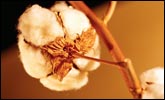| Contents |
 |
|
Page last reviewed: 07/11/2007
|

Cotton Dust
Cotton dust is often present in the air during
cotton handling and processing. Cotton dust may contain many
substances including ground-up plant matter, fiber, bacteria, fungi,
soil, pesticides, non-cotton matter, and other contaminants that may
have accumulated during growing, harvesting, and subsequent
processing or storage periods.
Cotton dust hazards are
addressed in specific standards for the general industry.
OSHA Standards
This section
highlights OSHA standards, Federal Registers (rules, proposed rules, and
notices), directives (instructions for compliance officers), and standard
interpretations (official letters of interpretation of
the standards) related to cotton dust.
Note: Twenty-five states, Puerto Rico and the Virgin
Islands have
OSHA-approved State Plans and have adopted their own standards and
enforcement policies. For the most part, these States adopt standards that are
identical to Federal OSHA. However, some States have adopted different standards
applicable to this topic or may have different enforcement policies.
General Industry (29 CFR 1910)
Federal Registers
Directives
-
Cotton Dust Manual. CPL 02-02-031 [CPL 2-2.31], (1981, January 16).
Establishes OSHA policy and procedures
necessary for enforcing at yarn manufacturing operations, at
slashing, weaving, knitting, waste house operations, and at
cotton warehousing operations on the premises of the cotton's
processors.
- Search all available
directives.
Standard Interpretations
Hazards and Possible Solutions
Workers may be unaware of the
potential hazards in their work environment, which makes them more
vulnerable to injury. The following references aid in recognizing and
finding possible solutions for cotton dust hazards.
Hazard Recognition
-
Cotton dust (raw). National Institute for Occupational
Safety and Health (NIOSH) Pocket Guide to Chemical Hazards. Provides the
physical description, exposure limits, and measurement methods
of cotton dust and many other chemical substances.
- Occupational
Respiratory Disease Surveillance. National Institute for
Occupational Safety and Health (NIOSH) Workplace Safety and Health Topic. Monitors the extent and
severity of occupationally-related lung disease and related
workplace exposures.
-
Work-Related Lung Disease (eWoRLD) Surveillance System - Volume 1: Byssinosis: Cotton Dust Exposure. National Institute for Occupational Safety and Health (NIOSH). Offers the user quick access to all summary tables, figures, and maps of the Report in three formats (html, gif, pdf, and data in csv) on byssinosis and cotton dust exposure.
Possible Solutions
-
Cotton Dust Manual. CPL 02-02-031 [CPL 2-2.31], (1981, January 16).
Establishes OSHA policy and procedures
necessary for enforcing at yarn manufacturing operations, at
slashing, weaving, knitting, waste house operations, and at
cotton warehousing operations on the premises of the cotton's
processors.
- Washed Cotton. US Department of Health and Human Services (DHHS), National Institute for Occupational Safety and Health
(NIOSH) Publication No. 95-113, (1995, August). Covers the health effects of cotton dust
exposure and offers various controls that can be implemented to
avoid illness.
- For additional information on possible solutions for cotton
dust related hazards, see OSHA's Safety and Health Topics Pages
on:
Additional Information
Related Safety and Health Topics Pages
Training
-
Spirometry. National
Institute for Occupational Safety and Health (NIOSH) Workplace Safety and Health Topic. Includes design of the
courses for those individuals who will be administering screening pulmonary
function testing to employees who are exposed to cotton dust, and lists of
course sponsors throughout the United States.
Other Resources
- Worker
Protection Standard. National Cotton Council (NCC). Provides information regarding
industry resources, government affairs, and cotton publications.
- The Way to Safety and Health for Textile
Finishing Workers. National Institute for Occupational
Safety and Health (NIOSH) Publication No. 77-208.
-
Profile of the Textiles Industry [5 MB PDF, 136 pages]. Environmental Protection
Agency (EPA) Sector Notebook Publication No. EPA/310-R-97-009,
(1997, November). Developed by EPA's Office of Compliance, this
industry notebook contains detailed information on various topics
that might be of interest to safety and health professionals. The
notebook has been reviewed by experts from both inside and outside
the EPA. Information covered includes: an industrial process
description, a comprehensive environmental profile, innovative
control programs, contacts, and a list of bibliographic
references.
Accessibility Assistance: Contact the OSHA Directorate of Technical Support and Emergency Management at (202) 693-2300 for assistance accessing PDF materials.
|


 Newsletter
Newsletter RSS Feeds
RSS Feeds Print This Page
Print This Page
 Text Size
Text Size

